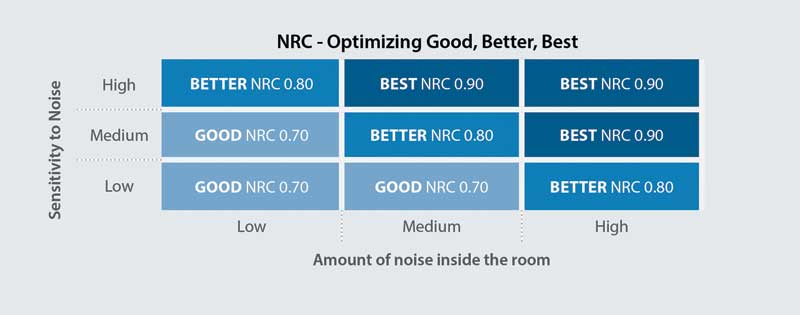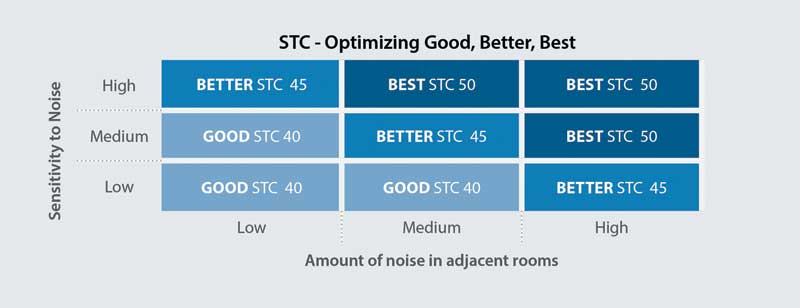Optimizing acoustics in offices

Optimizing absorption
It is important to select the correct sound absorption level for the ceiling panels in each type of space. This value can come from the applicable standard, or from an acoustics consultant such as a member of the Canadian Acoustical Association (CAA). (For more information, visit the Canadian Acoustical Association at www.caa-aca.ca.) Alternatively, it is possible to employ the optimizing absorption table (Figure 1) to determine the NRC value of the ceiling.
To use this table, first consider how much noise will be in the room (a low, medium, or high level). Will there be a lot of people or equipment generating noise inside the room? Next, one must consider how sensitive the occupants and the room function are to noise. For example, a call centre that handles prescription medication orders for those with age-related hearing impairment has both high potential for noise and high sensitivity to noise. Therefore, the optimal acoustic ceiling has an NRC of 0.90 or higher.
Optimizing blocking
After optimizing sound absorption for each type of space, the question of whether sound blocking is relevant or not should be considered. For many medium or large spaces containing a lot of people or equipment (e.g. airport concourses, retail spaces, restaurants, casinos, lobbies, and factories), sound blocking is not relevant. Where it is important, the optimizing blocking table (Figure 2) can be used.
It is best to begin by considering the potential for noise in adjacent spaces and ranking it as high, medium, or low. Then, one should consider how sensitive to noise the people using the space may be and how disruptive noise from adjacent spaces might be. For example, a special education classroom adjacent to a teacher’s lounge demonstrates both high sensitivity and high potential for noise. The demising wall should therefore achieve an STC rating of 50. Stopping the demising wall at the ceiling level and relying on the ceiling alone to block sound (CAC 20 to 35) is insufficient by 15 to 30 dB.

Other considerations
This article has focused on the architecture in office buildings—primarily walls and ceilings. However, other factors also contribute to good acoustics. For instance, the building’s mechanical, electrical, and plumbing systems need to be engineered for quiet operation. Fortunately, modern HVAC systems are much quieter than those used decades ago. The building also needs to be protected from exterior environmental noise, either by site selection, exterior noise control, or building façade noise control. Finally, audio, video, and sound masking systems—if used—need to be designed and installed correctly. These topics are beyond this article’s scope, but should still be considered in the pursuit of truly optimal acoustics.
Conclusion
Optimizing the acoustics of future buildings is straightforward. First, one should select the optimal level of absorption: NRC 0.70 (good), NRC 0.80 (better), or NRC 0.90 (best). Next, it is important to determine whether sound blocking is required. If so, one should optimize the level of blocking: STC 40 (good), STC 45 (better), or STC 50 and higher (best). Effective blocking can be achieved by placing lightweight plenum barriers above the walls, along with high-NRC acoustic ceilings. When this acoustic design approach is followed, not only will satisfaction be improved, but so will productivity and comfort.
Those contributing to the design and construction of future office buildings must consider how they want to move forward. Will they be part of the solution that increases worker satisfaction in offices? Or will they continue doing things the same old way? Those just starting their careers may want to think about these topics and begin to discuss the new way forward when they see an old specification or wall detail sheet that has been used ineffectively for the past decade.
Gary Madaras, Ph.D., Assoc. AIA, is an acoustics specialist for Rockfon. He leads Rockfon’s optimized acoustics efforts by working with designers and specifiers to select and utilize the appropriate data, products, and design approaches to comply with industry standards and achieve optimal acoustic experiences. He is a member of the Acoustical Society of America, Institute for Noise Control Engineering, and Canadian Acoustics Association. He can be contacted via e-mail at Gary.Madaras@Rockfon.com.







